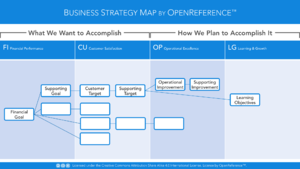A109
Difference between revisions of "A109"
m |
m |
||
| Line 6: | Line 6: | ||
An example of such metrics are the level-1 [[SCPM|metrics]] for each [[Attribute|Attribute]] defined in {{OR}}. Where necessary the level-2, 3, and 4 metrics are available to analyze and explain deviations between scorecard targets and actuals for each metric. | An example of such metrics are the level-1 [[SCPM|metrics]] for each [[Attribute|Attribute]] defined in {{OR}}. Where necessary the level-2, 3, and 4 metrics are available to analyze and explain deviations between scorecard targets and actuals for each metric. | ||
| + | A {{OR}} supply chain scorecard typically consists of 6-10 level-1 metrics. | ||
| − | [[File:OR-BSM.png|thumb|Business Strategy Map template]][[t:BSM]]{{OR}} recommends the use of a [[t:BSM]] to visualize and/or communicate the linkage between the business priorities and the metrics/attributes in a {{this}}. | + | |
| + | [[File:OR-BSM.png|thumb|Business Strategy Map template]][[t:BSM]]: {{OR}} recommends the use of a [[t:BSM]] to visualize and/or communicate the linkage between the business priorities and the metrics/attributes in a {{this}}. | ||
===Notes=== | ===Notes=== | ||
[[sc:A101|Busines plan review]] is a key step prior to defining scorecards. Without a deep understanding of the business plan, metrics are typically not --clearly-- linked to business priorities. Developing the [[t:BSM]] will reveal any gaps in linkage between priorities and metrics. | [[sc:A101|Busines plan review]] is a key step prior to defining scorecards. Without a deep understanding of the business plan, metrics are typically not --clearly-- linked to business priorities. Developing the [[t:BSM]] will reveal any gaps in linkage between priorities and metrics. | ||
Revision as of 17:14, 17 November 2021
The activities associated with the selection of the key metrics for each performance attribute for each supply chain. A scorecard is used to define the metrics of most interest to an organization, to arrange them by area of impact, by business priority, and to provide a container for later benchmarking comparisons. Each scorecard is built from a subset of hundreds of OpenReference metrics.
Contents
Use Cases
Balanced Scorecard: A standard method to analyze the performance of supply chains is the use of Balanced Scorecards. A Balanced Scorecard consists of a limited number of agreed, well-defined metrics, categorized by business perspective.
An example of such metrics are the level-1 Metrics for each Performance Attribute defined in OpenReference. Where necessary the level-2, 3, and 4 metrics are available to analyze and explain deviations between scorecard targets and actuals for each metric.
A OpenReference supply chain scorecard typically consists of 6-10 level-1 metrics.
Notes
Busines Plan Review is a key step prior to defining scorecards. Without a deep understanding of the business plan, metrics are typically not --clearly-- linked to business priorities. Developing the Business Strategy Map will reveal any gaps in linkage between priorities and metrics. The Discovery (A102) and Documentation/definition (A108) of supply chains are a key preceding steps. Without clearly defined supply chains, scorecards may contain aggregate data of conflicting supply chain types e.g. Make-to-Order and Make-to-Stock together.
Workflow
| Process |
| ||||||||||||||||||
|---|---|---|---|---|---|---|---|---|---|---|---|---|---|---|---|---|---|---|---|---|
|
A109 |
|
||||||||||||||||||

